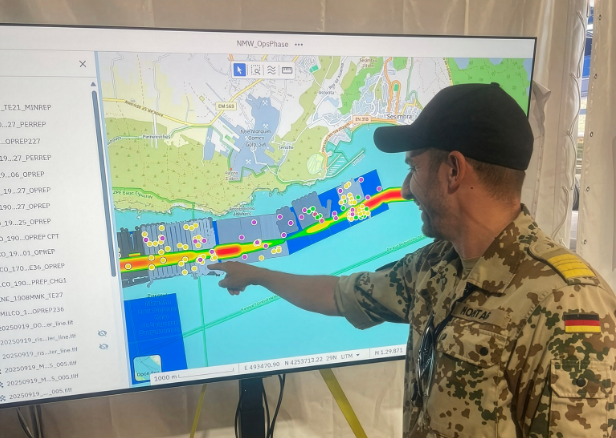
north.io, the ocean big data specialist, has demonstrated a transformational capability in naval mine countermeasures (MCM) during the REPMUS 2025 exercise in Portugal. The company reduced data processing times from days to minutes and enabled high-resolution operational pictures of the seabed to be generated in near real-time.
During the four-week NATO-led exercise, which combined the annual REPMUS (Robotic Experimentation and Prototyping with Maritime Unmanned Systems) exercise with Dynamic Messenger 2025, the company’s Ocean Data Platform served as the digital backbone for the German Navy’s Mine Countermeasures Task Unit, processing terabytes of sonar and sensor data from multiple autonomous uncrewed systems into a unified operational picture.
Quantum leap in data processing speed
The Ocean Data Platform addressed one of the most critical bottlenecks in MCM operations. Traditionally, the evaluation of sonar and sensor data required days or even weeks, significantly delaying operational decision-making. At REPMUS 2025, north.io’s technology compressed these timeframes dramatically – initially reducing post-processing from days to hours and ultimately delivering actionable intelligence to analysts’ desks in minutes.
“The Ocean Data Platform was the missing piece,” emphasised Commander Andreas Montag, Mine Countermeasures Commander Task Unit (CTU) during the exercise. “It allowed us to bring sensor data directly into the staff picture with unprecedented speed and precision. As the person responsible for the situation picture, I always had a quick, up-to-date, high-resolution and accurate picture of the seabed.”
MCMs operations were overseen from the fishing port of Sesimbra. There, north.io specialists operating from the so-called Data Fusion Cell, worked alongside the 3rd Minesweeping Squadron, experts from NATO’s Centre of Excellence for Mine Warfare (Belgium) and NATO’s Centre for Maritime Research and Experimentation (La Spezia).
Strategic integration with NATO systems
A milestone achievement at REPMUS 2025 was the first-time integration of the Ocean Data Platform with Systematic’s SitaWare command and control (C2) software, which is used internationally and by the German Navy for operational command pictures.
“Not only is a central ocean data management system necessary, but the agnostic connection to a combat management system (CMS) was also established for the first time during the exercise by north.io,” noted Commander Guy Phlippo, Director of Maritime Unmanned Systems Integration and Industry Engagement at NATO in Brussels.
This integration enabled underwater data from autonomous drones and sensors to flow directly into the German CTU’s operational command picture – a decisive step toward fully networked, multi-national MCM operations, improved percentage clearances and shorter detect-to-engage timelines.
Application beyond MCM
The platform’s capabilities extended beyond mine countermeasures. Commander Nadia Rijo from NATO’s Maritime Geospatial Centre of Excellence in Lisbon, whose group conducted Rapid Environmental Assessment during the exercise, stated: “The Ocean Data Platform technology far exceeded our expectations. The system delivered more than we had requested, especially in terms of the rapid processing and visualisation of large amounts of environmental data. We immediately recognised the added value this platform offers for future NATO operations.”
The Ocean Data Platform’s versatility was further demonstrated through its integration with Rheinmetall’s Harbor Protection Container system, where it consolidated all operational data for sea and air surveillance in a port protection scenario. This highlighted the system’s potential as a backbone for comprehensive maritime security solutions protecting critical national infrastructure.
Strategic importance for European security
north.io’s successful demonstration has immediate operational relevance for securing NATO’s ‘Q routes’ – shipping routes essential for the resupply of northern Germany and the Baltic states during periods of tension or conflict.
Rear Admiral Dirk Gärtner, Head of Planning and Design at the Naval Command in Rostock, who visited the exercise and received briefings at the Sesimbra situation centre, concluded, “The exercise impressively demonstrated how the German Navy, together with industry partners and allies, is digitally advancing its mine defence capabilities into the future. The networking of systems-of-systems and the speed with which data can be processed and made available today are particularly significant advances.”
Innovation from Germany
“We have proven how innovative and mature our technology readiness is – and also how young, innovative companies in particular can make a very significant contribution to the further development of capabilities in the navy,” said Jann Wendt, founder and co- CEO of north.io. “The milestones reached at REPMUS could be a real game-changer.”


















